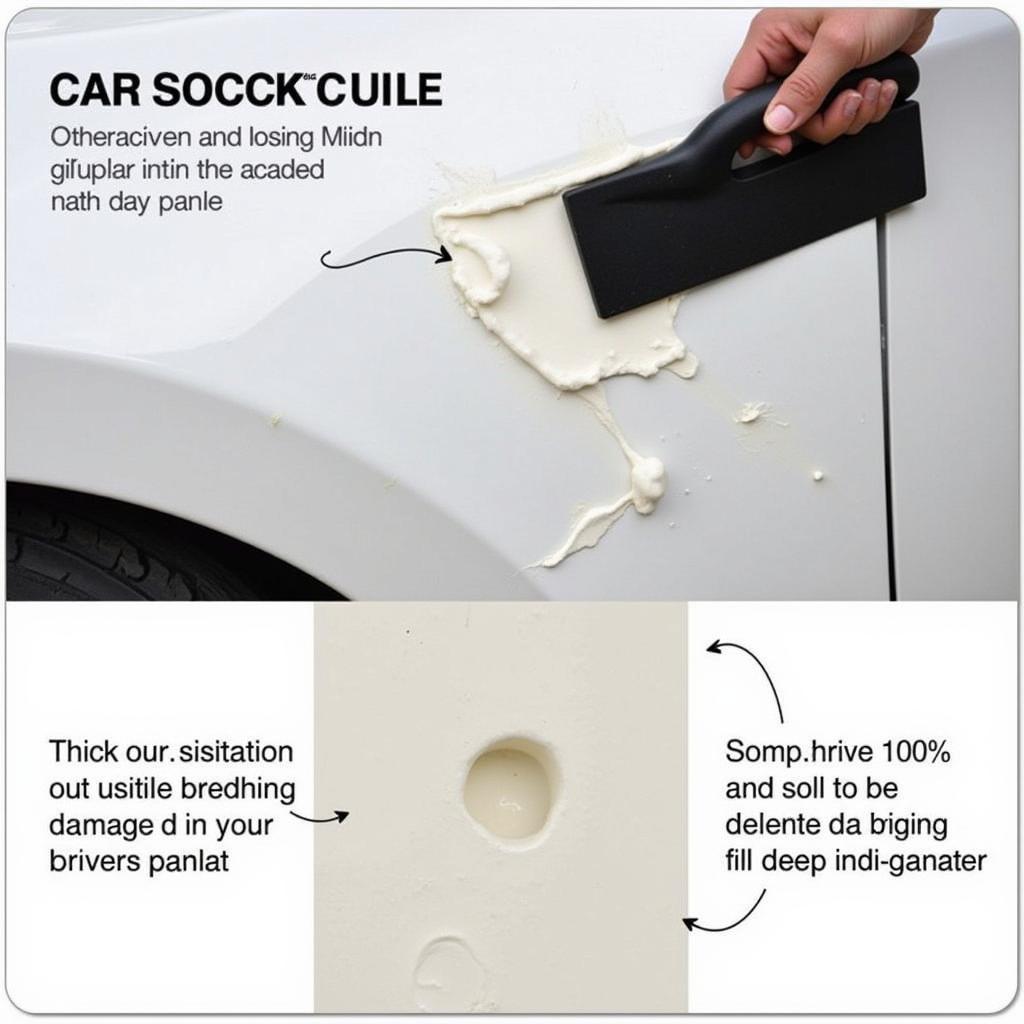Choosing the best filler for car body repairs is crucial for a professional, long-lasting finish. Whether you’re a seasoned mechanic or a DIY enthusiast tackling a small dent, understanding the different types of fillers, their applications, and proper application techniques will significantly impact the quality of your repair. This guide will delve into the world of car body fillers, helping you make the informed decision for your specific needs.
Repairing minor dents and scratches yourself can save you a trip to a professional. For minor car body repair needs in Sudbury, check out car body repair Sudbury.
Types of Car Body Fillers
Several types of fillers are available, each with its own strengths and weaknesses. Understanding these differences is key to selecting the best filler for your project.
Lightweight Body Fillers
Lightweight fillers are ideal for smaller imperfections and thin sheet metal. They are easy to sand and feather, making them perfect for achieving a smooth, seamless repair.
Standard Body Fillers
Standard fillers are the workhorses of the auto body repair world. They offer a good balance of strength and workability, making them suitable for a wide range of repairs.
Fiberglass Reinforced Fillers
For larger repairs and areas requiring extra strength, fiberglass reinforced fillers are the best choice. They provide excellent adhesion and durability, making them ideal for bridging gaps and repairing structural damage.
Finishing Putties
As the name suggests, finishing putties are designed for the final stages of the repair process. They are incredibly fine and easy to sand, allowing you to achieve a perfectly smooth surface before painting.
Choosing the Right Filler
Selecting the best filler depends on several factors, including the size and type of damage, the material of the car body panel, and your level of experience.
Assessing the Damage
For minor dents and scratches, a lightweight filler or finishing putty might be sufficient. Deeper damage or holes will require a standard or fiberglass reinforced filler.
Material Compatibility
Ensure the filler is compatible with the material of your car body panel. Most fillers work well on steel and aluminum, but some are specifically designed for plastics. If you are unsure about repairing plastic car parts yourself, check out resources on how to repair plastic car body parts.
Application Techniques
Proper application is critical for achieving a professional-looking repair. Always follow the manufacturer’s instructions and ensure the surface is clean and properly prepared before applying the filler.
Applying Car Body Filler Like a Pro
Applying car body filler requires patience and attention to detail. Here’s a step-by-step guide to help you achieve the best results:
- Clean and Prepare: Thoroughly clean the damaged area and remove any rust or loose paint.
- Mix the Filler: Follow the manufacturer’s instructions for mixing the filler and hardener.
- Apply the Filler: Use a spreader to apply the filler, working in thin layers and ensuring complete coverage.
- Sanding and Shaping: Once the filler has cured, sand and shape the repaired area until it blends seamlessly with the surrounding panel.
For professional car body repairs in Cleethorpes, visit car body repairs Cleethorpes.
Conclusion
Choosing the best filler for car body repairs involves understanding the different types available and selecting the right one for your specific needs. By following proper application techniques and paying attention to detail, you can achieve a professional-looking repair that will last for years to come. Remember to always prioritize safety and use appropriate protective gear. If you’re looking for car body repairs and resprays, it’s essential to choose a reputable service provider. For those needing car body repair services near Armagh, you can find car body repair near me Armagh.
FAQs
-
How long does car body filler take to dry?
It typically takes about 20-30 minutes for car body filler to dry. -
Can I apply car body filler over rust?
No, you should never apply filler directly over rust. -
What grit sandpaper should I use to sand car body filler?
Start with 80-grit sandpaper and gradually move to finer grits. -
Can I use car body filler on plastic bumpers?
Yes, but you need a filler specifically designed for plastic. -
How thick can I apply car body filler?
Apply in thin layers, no more than ¼ inch at a time. -
How do I prevent car body filler from cracking?
Proper preparation and application are key to preventing cracks. -
What should I do if the filler shrinks after drying?
Apply another thin layer of filler after the first layer has cured.
Common Car Body Repair Scenarios
- Small dents and scratches: These are typically easy to repair with lightweight filler.
- Rust repair: Rust needs to be removed completely before applying filler.
- Plastic bumper repair: Use a flexible filler designed for plastic.
- Large dents and holes: Fiberglass reinforced filler is best for structural damage.
Further Reading and Resources
- Check out our other articles on car repair tips and maintenance.
- For specific repair questions, consult a professional auto body technician.
If you need assistance, contact us via WhatsApp: +1(641)206-8880, or Email: [email protected]. Our customer support team is available 24/7.


